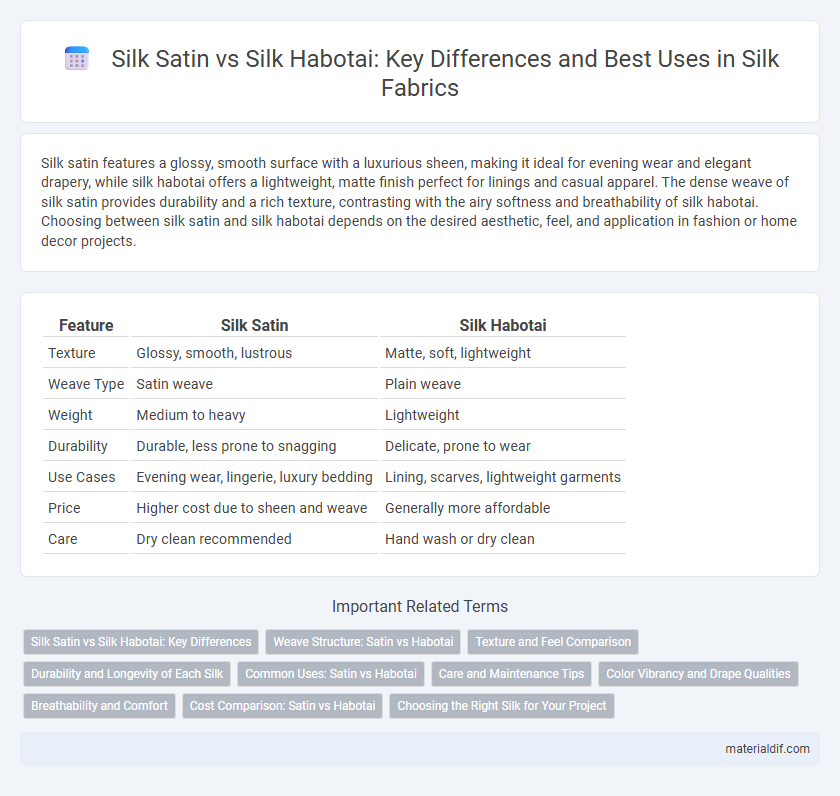Silk satin features a glossy, smooth surface with a luxurious sheen, making it ideal for evening wear and elegant drapery, while silk habotai offers a lightweight, matte finish perfect for linings and casual apparel. The dense weave of silk satin provides durability and a rich texture, contrasting with the airy softness and breathability of silk habotai. Choosing between silk satin and silk habotai depends on the desired aesthetic, feel, and application in fashion or home decor projects.
Table of Comparison
| Feature | Silk Satin | Silk Habotai |
|---|---|---|
| Texture | Glossy, smooth, lustrous | Matte, soft, lightweight |
| Weave Type | Satin weave | Plain weave |
| Weight | Medium to heavy | Lightweight |
| Durability | Durable, less prone to snagging | Delicate, prone to wear |
| Use Cases | Evening wear, lingerie, luxury bedding | Lining, scarves, lightweight garments |
| Price | Higher cost due to sheen and weave | Generally more affordable |
| Care | Dry clean recommended | Hand wash or dry clean |
Silk Satin vs Silk Habotai: Key Differences
Silk satin features a glossy, smooth surface with a luxurious sheen created by a satin weave, making it ideal for evening gowns and high-end lingerie. Silk habotai, also known as China silk, has a lightweight, plain weave with a matte finish and breathable texture commonly used for linings and summer garments. The primary differences lie in their weave structure, texture, and sheen, influencing their respective softness, durability, and suitable applications in fashion and textiles.
Weave Structure: Satin vs Habotai
Silk satin features a dense weave with a four-over, one-under pattern, creating a smooth, lustrous surface that reflects light brilliantly. Silk habotai utilizes a plain weave with a one-over, one-under structure, resulting in a lightweight, matte finish with a softer drape. The difference in weave structure impacts the fabric's texture, sheen, and suitability for various applications such as eveningwear for satin and linings or lightweight garments for habotai.
Texture and Feel Comparison
Silk satin features a glossy, smooth surface with a luxurious sheen that feels soft and slippery against the skin, making it ideal for elegant garments and bedding. In contrast, Silk habotai has a lightweight, matte finish with a slightly crisp texture, offering a breathable and comfortable feel perfect for linings and summer wear. The difference in weave structure between satin's dense, lustrous weave and habotai's plain, open weave directly influences their tactile qualities and drape.
Durability and Longevity of Each Silk
Silk satin features a dense weave that enhances durability and resists wear, making it ideal for long-lasting garments and upholstery. Silk habotai, while softer and lightweight, has a looser weave that can lead to quicker wear and reduced longevity under frequent use. Choosing silk satin over habotai improves the durability and lifespan of silk products, especially in high-contact applications.
Common Uses: Satin vs Habotai
Silk satin is commonly used for luxurious evening gowns, lingerie, and high-end bedding due to its glossy surface and smooth texture that enhances elegance and comfort. Silk habotai, known for its lightweight and breathable qualities, is often used in linings, scarves, and summer garments where softness and airflow are essential. Satin's heavier weight and sheen make it ideal for formal apparel, while habotai's matte finish suits everyday wear and delicate accessories.
Care and Maintenance Tips
Silk satin requires gentle hand washing with mild detergent and air drying away from direct sunlight to maintain its glossy finish and prevent fiber damage. Silk habotai, being lighter and more breathable, also benefits from cold water washing and avoiding wringing to preserve its softness and prevent shrinkage. Both fabrics should be stored in a cool, dry place and ironed on low heat with a cloth barrier to avoid scorching or sheen loss.
Color Vibrancy and Drape Qualities
Silk satin offers superior color vibrancy due to its tightly woven structure and glossy surface, which enhances light reflection and saturation. Silk habotai, while softer and lighter, presents a more muted color palette with a matte finish that absorbs light rather than reflecting it. The drape qualities of silk satin are heavier and more fluid, creating elegant folds, whereas silk habotai has a lighter, more airy drape suitable for delicate layering.
Breathability and Comfort
Silk satin offers a smooth, glossy finish but tends to be less breathable compared to silk habotai, which is lightweight and highly breathable, making it ideal for warm weather. Habotai's fine, plain weave allows better air circulation, enhancing comfort during prolonged wear. For those prioritizing breathability and softness, silk habotai provides superior moisture-wicking properties and a gentle feel against the skin.
Cost Comparison: Satin vs Habotai
Silk satin typically commands a higher price than silk habotai due to its complex weaving technique and glossy finish, making it a luxury fabric preferred for formalwear and high-end bedding. Habotai silk, known for its lightweight and breathable properties, is more affordable and commonly used in linings and casual apparel. The cost difference reflects satin's premium texture and durability versus habotai's simplicity and versatility.
Choosing the Right Silk for Your Project
Silk satin offers a glossy, smooth finish ideal for luxurious eveningwear and elegant drapery, while silk habotai is lightweight with a matte sheen perfect for linings, blouses, and delicate scarves. When choosing the right silk for your project, consider the end use--silk satin's heavier weave provides durability and sheen, whereas silk habotai's softness and breathability enhance comfort and fluidity. Evaluating fabric weight, texture, and intended garment function ensures optimal selection between these two popular silk types.
Silk satin vs Silk habotai Infographic

 materialdif.com
materialdif.com